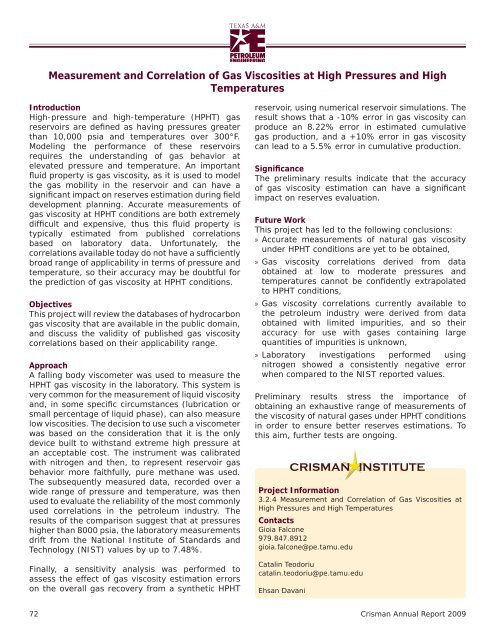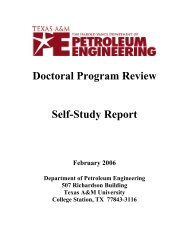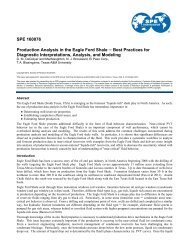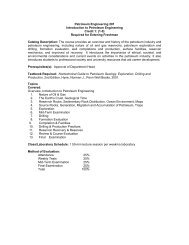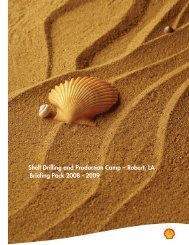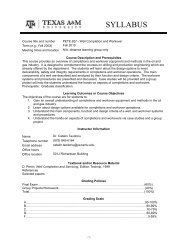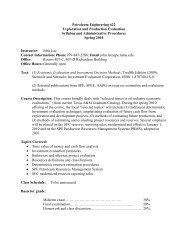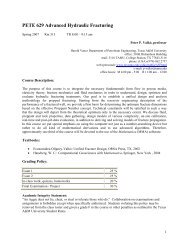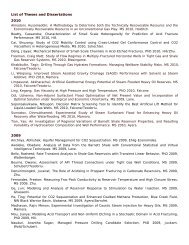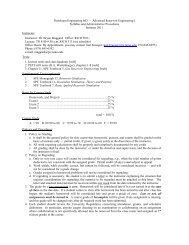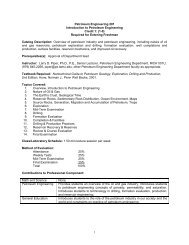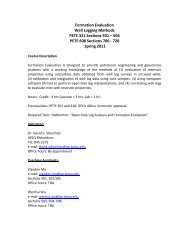Crisman Annual Report 2009 - Harold Vance Department of ...
Crisman Annual Report 2009 - Harold Vance Department of ...
Crisman Annual Report 2009 - Harold Vance Department of ...
Create successful ePaper yourself
Turn your PDF publications into a flip-book with our unique Google optimized e-Paper software.
Measurement and Correlation <strong>of</strong> Gas Viscosities at High Pressures and High<br />
Temperatures<br />
Introduction<br />
High-pressure and high-temperature (HPHT) gas<br />
reservoirs are defined as having pressures greater<br />
than 10,000 psia and temperatures over 300°F.<br />
Modeling the performance <strong>of</strong> these reservoirs<br />
requires the understanding <strong>of</strong> gas behavior at<br />
elevated pressure and temperature. An important<br />
fluid property is gas viscosity, as it is used to model<br />
the gas mobility in the reservoir and can have a<br />
significant impact on reserves estimation during field<br />
development planning. Accurate measurements <strong>of</strong><br />
gas viscosity at HPHT conditions are both extremely<br />
difficult and expensive, thus this fluid property is<br />
typically estimated from published correlations<br />
based on laboratory data. Unfortunately, the<br />
correlations available today do not have a sufficiently<br />
broad range <strong>of</strong> applicability in terms <strong>of</strong> pressure and<br />
temperature, so their accuracy may be doubtful for<br />
the prediction <strong>of</strong> gas viscosity at HPHT conditions.<br />
Objectives<br />
This project will review the databases <strong>of</strong> hydrocarbon<br />
gas viscosity that are available in the public domain,<br />
and discuss the validity <strong>of</strong> published gas viscosity<br />
correlations based on their applicability range.<br />
Approach<br />
A falling body viscometer was used to measure the<br />
HPHT gas viscosity in the laboratory. This system is<br />
very common for the measurement <strong>of</strong> liquid viscosity<br />
and, in some specific circumstances (lubrication or<br />
small percentage <strong>of</strong> liquid phase), can also measure<br />
low viscosities. The decision to use such a viscometer<br />
was based on the consideration that it is the only<br />
device built to withstand extreme high pressure at<br />
an acceptable cost. The instrument was calibrated<br />
with nitrogen and then, to represent reservoir gas<br />
behavior more faithfully, pure methane was used.<br />
The subsequently measured data, recorded over a<br />
wide range <strong>of</strong> pressure and temperature, was then<br />
used to evaluate the reliability <strong>of</strong> the most commonly<br />
used correlations in the petroleum industry. The<br />
results <strong>of</strong> the comparison suggest that at pressures<br />
higher than 8000 psia, the laboratory measurements<br />
drift from the National Institute <strong>of</strong> Standards and<br />
Technology (NIST) values by up to 7.48%.<br />
Finally, a sensitivity analysis was performed to<br />
assess the effect <strong>of</strong> gas viscosity estimation errors<br />
on the overall gas recovery from a synthetic HPHT<br />
reservoir, using numerical reservoir simulations. The<br />
result shows that a -10% error in gas viscosity can<br />
produce an 8.22% error in estimated cumulative<br />
gas production, and a +10% error in gas viscosity<br />
can lead to a 5.5% error in cumulative production.<br />
Significance<br />
The preliminary results indicate that the accuracy<br />
<strong>of</strong> gas viscosity estimation can have a significant<br />
impact on reserves evaluation.<br />
Future Work<br />
This project has led to the following conclusions:<br />
» Accurate measurements <strong>of</strong> natural gas viscosity<br />
under HPHT conditions are yet to be obtained,<br />
» Gas viscosity correlations derived from data<br />
obtained at low to moderate pressures and<br />
temperatures cannot be confidently extrapolated<br />
to HPHT conditions,<br />
» Gas viscosity correlations currently available to<br />
the petroleum industry were derived from data<br />
obtained with limited impurities, and so their<br />
accuracy for use with gases containing large<br />
quantities <strong>of</strong> impurities is unknown,<br />
» Laboratory investigations performed using<br />
nitrogen showed a consistently negative error<br />
when compared to the NIST reported values.<br />
Preliminary results stress the importance <strong>of</strong><br />
obtaining an exhaustive range <strong>of</strong> measurements <strong>of</strong><br />
the viscosity <strong>of</strong> natural gases under HPHT conditions<br />
in order to ensure better reserves estimations. To<br />
this aim, further tests are ongoing.<br />
Project Information<br />
3.2.4 Measurement and Correlation <strong>of</strong> Gas Viscosities at<br />
High Pressures and High Temperatures<br />
Contacts<br />
Gioia Falcone<br />
979.847.8912<br />
gioia.falcone@pe.tamu.edu<br />
Catalin Teodoriu<br />
catalin.teodoriu@pe.tamu.edu<br />
Ehsan Davani<br />
CRISMAN INSTITUTE<br />
72<br />
<strong>Crisman</strong> <strong>Annual</strong> <strong>Report</strong> <strong>2009</strong>


